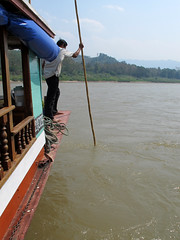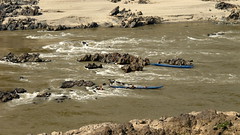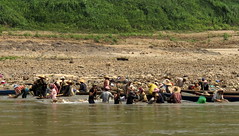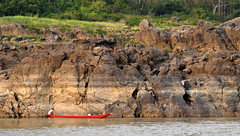The Mekong River starts in the Tibetan plateau, and wends its way through deep gorges in China’s Yunnan region and into Burma to the Golden Triangle area where the borders of Burma, Thailand and Laos meet. After defining the border between Thailand and Laos, it veers east and then south to flow through Laos and Cambodia, spilling out into the South China Sea in Vietnam — some 4,350 kms from its source.
 Our slow boat trip from Chiang Khong to Luang Prabang gave us a sobering insight into how important the water in this river is to the lives of the Laotian people who live along its banks.
Our slow boat trip from Chiang Khong to Luang Prabang gave us a sobering insight into how important the water in this river is to the lives of the Laotian people who live along its banks.
 The water was unusually low in February 2010 — the lowest levels in a generation — and navigation was limited to boats with a shallow draft. Our slow boat managed, but barely: the first mate used a bamboo pole to plumb the depth and show the captain as they navigated several rapids. We’d been warned that we would need to walk around one set of rapids and change boats.
The water was unusually low in February 2010 — the lowest levels in a generation — and navigation was limited to boats with a shallow draft. Our slow boat managed, but barely: the first mate used a bamboo pole to plumb the depth and show the captain as they navigated several rapids. We’d been warned that we would need to walk around one set of rapids and change boats.
Our boat pushed up onto a sandbar and we disembarked, bringing our packs with us to make our way along a path. As the rapids came into view, there was no doubt why this was necessary: a small boat might make it, but jagged rocks across the span would wreck any larger boat foolish enough to try.
Our guide told us that a few days before our cruise, a larger boat had hit a rock further downstream and capsized. Fortunately, nobody had been injured, but the boat was destroyed, and word had quickly spread to cause a steep decline in downriver cruise bookings.
 We looked back more soberly at the rapids and rocks from the calmer water where a second boat was waiting, then boarded it for the journey to Pak Beng. Our original boat returned empty to Huay Xai. The low water levels would certainly have an impact on the fortunes of the Mekong boat operators.
We looked back more soberly at the rapids and rocks from the calmer water where a second boat was waiting, then boarded it for the journey to Pak Beng. Our original boat returned empty to Huay Xai. The low water levels would certainly have an impact on the fortunes of the Mekong boat operators.
 Not all impacts are directly negative however. All along the banks we saw people panning for gold. Low water levels expose gravel and sand caught behind otherwise inaccessible underwater rocks — ideal locations for specs of gold to be hidden. Some bars must have been particularly promising because dozens of people were busy digging sand and panning. Our guide told us that river traders would buy gold from these people — mostly otherwise subsistence farmers — and sell it for a profit downstream.
Not all impacts are directly negative however. All along the banks we saw people panning for gold. Low water levels expose gravel and sand caught behind otherwise inaccessible underwater rocks — ideal locations for specs of gold to be hidden. Some bars must have been particularly promising because dozens of people were busy digging sand and panning. Our guide told us that river traders would buy gold from these people — mostly otherwise subsistence farmers — and sell it for a profit downstream.
The town of Pak Beng is the only place with accommodation, and depends on river traffic. As fewer boats bring fewer passengers downriver, business will decline for the local guesthouses and restaurants, and the local market will sell less produce from the nearby farms. Fewer boats mean reduced markets for the river fishermen, who sell their catch to passing boats.
 By the time we reached Luang Prabang, tributaries had added more water to the Mekong. However, waterline marks on the rocky banks, and the lower extent of the many riverbank gardens along its shores showed that river levels were still below normal expectations.
By the time we reached Luang Prabang, tributaries had added more water to the Mekong. However, waterline marks on the rocky banks, and the lower extent of the many riverbank gardens along its shores showed that river levels were still below normal expectations.
Luang Prabang has an airport, and is connected by roads to other parts of Laos, but the Mekong River is a powerful draw. As we enjoyed a drink on one of the many terraces overlooking the river, we wondered about the ongoing debates about whether the problem is part of a natural cycle, another sign of global warming, or a result of new dams in China.
For many of the people in Laos, the reasons hardly matter. They rely on the Mekong River, and will certainly suffer if such low levels continue or repeat.
